Filling your home with lush, green plants is an effective way to make it more beautiful and give it a peaceful, relaxing feeling. Unfortunately, buying enough plants to fill the average home can add up to a lot of money, often enough to break your budget. One trick you can use to feed your plant habit is taking cuttings from the ones you already have, and rooting them to make new plants. Here are 10 of our favorite candidates.
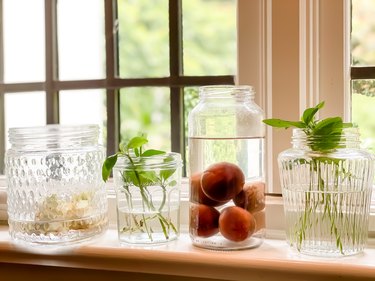
Video of the Day
1. Aromatic, Flavorful Kitchen Herbs
Many common kitchen herbs including sage, mint, basil, oregano, thyme and rosemary will happily root for you in a glass of water. If you already have a windowsill herb garden, cutting back and replanting periodically will help keep it full and beautiful. If you're currently buying your herbs, storing them in a glass of water will give you cuttings you can transplant, or just keep them usable for longer. Start with a cutting 4 to 6 inches long from the tip of the herb. Make a clean cut below a leaf node, and put it in a glass of clean water. Keep them in a well-lighted spot until roots develop, changing the water periodically, until you've got roots.
Video of the Day
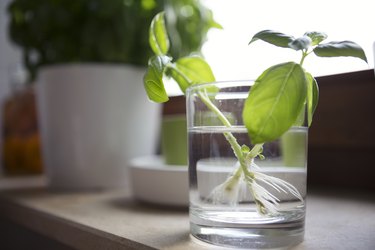
2. Versatile, Variable Ivy
Ivy is a quintessential house plant. It's available in a range of sizes, and in glossy greens or variegated hues that work well separately or in mixed pots. It looks great in hanging pots, or dangling over the edge or your shelves. Best of all, it propagates easily in water. Take several cuttings of bright, new growth from your healthiest plants, and strip back the leaves from the bottom of each cutting. Place them in water, give them a sunny spot to grow, and wait a few weeks until their roots are well established before potting them into soil.
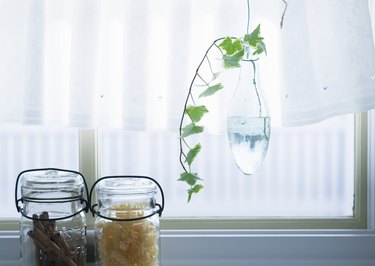
3. Vibrant Begonias
Begonias provide a long-lasting display of beautiful blossoms in a range of colors, and they're just as happy to root from cuttings as popular vining plants like ivy. Take cuttings from healthy, lanky stems, ideally when you're cutting it back anyway to encourage thick, bushy growth. Trim the bottom leaves from 4- to 6- inch cuttings, making a clean cut just below a leaf node. Change the water frequently, and after a month you should be seeing plenty of roots. Once they're a couple of inches long, usually in another month or so, you can pot them up.
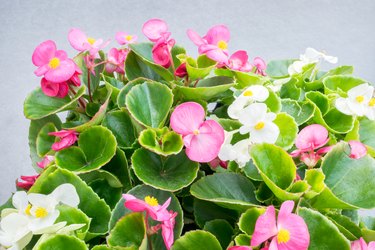
4. Colorful Prayer Plant
If you have a prayer plant, you already know that its bold pattern and vivid colors add a lot of life to your rooms. It's also a plant that roots enthusiastically in water, which makes it an easy option for expanding your collection. Examine the stems of your plants for the bumps, or nodes, where new leaves will soon grow. Cut the stem cleanly, just below one of those nodes, and place the cutting in a glass of water. Chlorine is bad for your new baby, so use bottled water or let your tap water sit overnight — to let the chlorine evaporate — before using it.

5. Fast-Growing Pothos
Pothos is a familiar decorative element in offices and waiting rooms everywhere, because it tolerates poor lighting better than a lot of houseplants. It's appealing in its own right, though, with glossy green or variegated leaves, and the vines can be left to dangle or grown along the wall for 30 or 40 feet. Propagate Pothos by cutting a stem with three or four leaves just below the bottom leaf, then leaving the two at the top but cutting away the bottom one or two. Left in a glass of water, the nodes where the two leaves were removed will grow new roots.
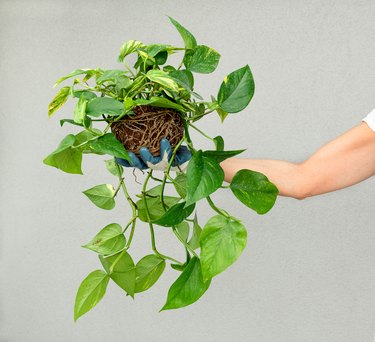
6. Boldly Colorful Croton
Croton is a big and dramatic houseplant that grows to small-tree size outdoors. This means propagating your own can rapidly fill up any empty spaces in your home. Choose new growth for your cuttings, just below the point where the new green growth has begun to get tough and woody. Cut at a 45-degree angle, and keep them in a glass or jar of water for about four weeks until the roots are well started (rooting hormone helps) before transplanting them into pots with well-drained soil.
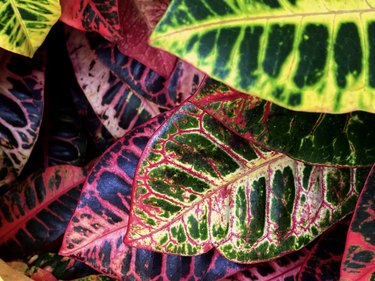
7. Fast-Rooting Tradescantia
Tradescantia is a fast-growing vining plant that trails beautifully and works well in hanging pots. It needs to be cut back periodically to stay healthy, so choose a few good cuttings 6 to 10 inches in length, and strip off all but the top handful of leaves. After less than a week in water, the cuttings will have viable roots that you can either plant in their own pots to start new plants, or put back in the original pot to create a larger, bushier cluster.

8. Thick-Growing Coleus
Coleus is an easy plant to grow, and it brings a splash of bold color to any area where it can get enough light. Cutting it back regularly encourages it to be big and bushy instead of long and lanky. When you cut it back, those cuttings will happily take root in water. Trim each cutting neatly to 4 or 6 inches in length, snipping it just below a leaf node, then strip away several of the bottom leaves. Place the cuttings in a jar or glass of water, and give it a spot where it'll receive lots of indirect light. In 2 to 3 weeks you'll have viable roots, and can transplant them to new pots or insert them alongside the parent plant to make it even larger and bushier.
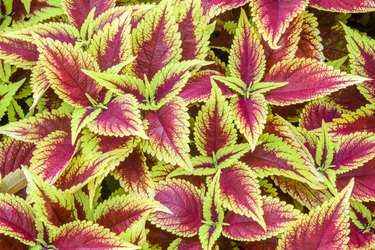
9. Beautiful Impatiens
Impatiens are beautiful and colorful flowers that are ridiculously easy to propagate from cuttings in water. Start by taking several nice, straight cuttings that are 3 to 4 inches in length, then stripping away the leaves from most of the cuttings' length (leave a few at the top to provide photosynthesis). Fill a transparent glass or jar with water, cover it with plastic wrap, and poke a few holes in the top for your cuttings. Gently push the stems through, until the stems are well immersed and supported by the film. Put the glass in a place with lots of indirect light, and in a few days you'll see roots. Once they're well established, transplant the slips into potting mix and water them well.

10. Exotic, Leafy "ZZ Plant"
Zamioculcas zamiifolia, better known as "ZZ plant" or "dollar tree," isn't a fast-growing plant, but it makes up for its leisurely habits by being superbly low-maintenance and happy with low-to-moderate light. Mature plants can be divided but that takes a while because of its slow growth, so rooting leaves in water is a quicker way to expand on your investment in ZZ plants. Cut through the leaf as close to the bottom as you can get it, and strip away any little leaflets that may be growing there (those can be propagated separately in soil, but tend to rot in water). It can take anywhere from 2 to 12 months, but eventually you'll see new tuber-like rhizomes growing from the leaf. At that point, it can be rooted in soil.
